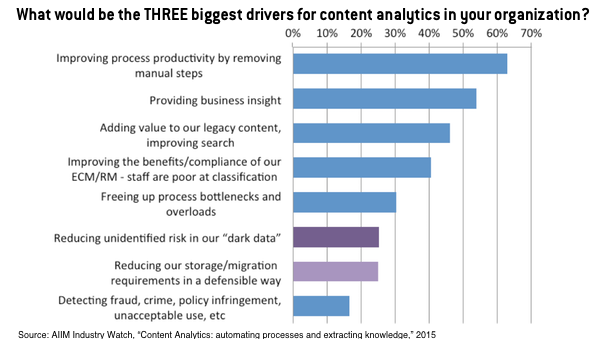
I bet you are thinking this article is about breaking down silos of information using integration. In most cases, you would be right, but this time, I am going to be discussing the use of content analytics.
A recent AIIM Industry Watch Report, titled “Content Analytics: automating processes and extracting knowledge,” finds that process productivity, business insight and adding value to legacy content take the top places when it comes to key drivers for content analytics. These top drivers are followed by improving the benefits and compliance of enterprise content management (ECM)/records management (RM), through more consistent declaration and classification of records, as well as reducing unidentified risk in what is termed “dark data” (content which may contain sensitive or personally identifiable information about customers/staff or may have business sensitivity that has not officially been identified).

Consider this
There is content stored in many places across your enterprise. Some of it may be housed within a dedicated repository, some in shared drives, network drives and other locations inside or outside of your corporate walls. This information has been tagged in some way or form, for the benefit of user findability, and not always from a corporate perspective. In many cases, these bits of content have value—not only for the intended audience but potentially for others who may be in a different department. The problem is that they do not know it exists. So, the content value in these cases is limited to the initial audience when it could, and should be, increased by sharing it with others. This is where content analytics becomes advantageous.
The biggest challenge for most organizations is the human factor. Humans do not like to file, nor do they like having to sift through content they need for business use. They want to find what they need when they need it. Even more of a challenge is getting them to delete ROT content—this is content that is redundant, outdated or trivial and no longer of value. Not only do they not like this responsibility, but they are generally bad at it.
Machines provide greater levels of consistency. When supplied with the business rules and criteria for classification or deletion, they can hugely reduce unwanted content and uncover content that holds value for the organization. As a result, searchability improves, business value of the remaining content is increased and extended across the organization and any sensitive content is identified and made secure. Additionally, you can perform meaningful extraction of comments, opinions, diagnoses, reports, claims, social chat and so on to gain business insight, improve competitive advantage or achieve fast response.
What to think about
The ability of computers to recognize not only characters but also the meaning in text, sound or images has progressed steadily over the years. Use of multi-processors and the ongoing refinement of recognition and analytics software enhance processing speeds, accuracy of recognition and increase support for a wide range of applications. As a result, we can match content with rules and policies, detect unusual behaviors or activity in credit accounts, spot patterns and trends in search activities and even infer emotions and sentiments. Content analytics is an integral part of “big data,” the business intelligence effort, and is also driving more organizations to embrace auto-classification, content remediation, security correction, adaptive case management and operations monitoring.
The first step for any analytic process is capture and recognition. Whether from paper, emails or other inbound channels, it involves validation and intelligent deduction based on word matching and sentence construct. Similarly, these principles can be applied to search and knowledge extraction in order to move beyond simple keywords to contextual analysis and take into account the significance and use of the search terms, providing increased value to the user and the organization as a whole.
In my view
Content analytics is a direction many organization can benefit from to improve operations and increase the value of their content. While there may be value in content initially, there is enhanced value by identifying it and making it available for others within the enterprise. Sales professionals benefit from knowing in advance client issues before they place a call. Case workers are more effective when they are provided information that could be related to their case and might otherwise not have known it existed had it not been identified and matched to the case profile. The time is here to explore the potential of content analytics to unlock your content and increase its value to your organization.
Bob Larrivee is director of custom research at AIIM and an internationally recognized subject matter expert and thought leader with over 30 years of experience in the fields of information and process management. He is an avid techie with a focus on process improvement and the application of advanced technologies to enhance and automate business operations. Follow him on Twitter @BobLarrivee.


























